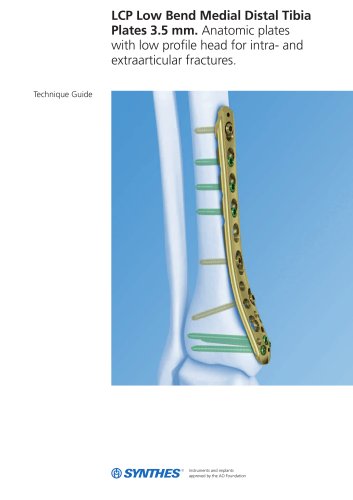
Catalog excerpts

LCP Proximal Femoral Hook Plate Plating System. Technique Guide
Open the catalog to page 1
Introduction Features and Benefits 2 Product Information Plates 17 O Image intensifier control This description is not sufficient for immediate application of the instrumentation. Instruction by a surgeon experienced in handling this instrumentation is highly recommended.
Open the catalog to page 3
Features and Benefits The Synthes LCP Proximal Femoral Hook Plate 4.5/5.0 is part of the LCP Periarticular Plating System, which merges locking screw technology with conventional plating techniques. LCP Periarticular Plating System The LCP Periarticular Plating System is capable of addressing: – complex fractures of the distal femur with the LCP Condylar Plate 4.5/5.0. – complex fractures of the proximal femur with the LCP Proximal Femoral Plate 4.5/5.0 or the LCP Proximal Femoral Hook Plate 4.5/5.0. – complex fractures of the proximal tibia with the LCP Proximal Tibial Plate 4.5/5.0 or the...
Open the catalog to page 4
LCP Proximal Femoral Hook Plate System The LCP Proximal Femoral Hook Plate System has many similarities to traditional plate fixation methods, with a few important improvements. The technical innovation of locking screws provides the ability to create a fixed-angle construct while using familiar AO plating techniques. Locking capability is important for a fixed-angle construct in osteopenic bone or multifragment fractures where screw purchase is compromised. These screws do not rely on plate-to-bone compression to resist patient load, but function similarly to multiple, small angled blade...
Open the catalog to page 5
AO Principles In 1958, the AO formulated four basic principles, which have become the guidelines for internal fixation.1 Those principles as applied to the LCP Proximal Femoral Hook Plate 4.5/5.0 are: Anatomic reduction Proximal hooks and anatomic plate profile assist reduction of metaphysis to diaphysis and facilitate restoration of the neckshaft angle by proper screw placement. Stable fixation The combination of conventional and locking plate fixation offers optimum fixation irrespective of bone density. Preservation of blood supply A limited-contact design reduces plate-to-bone contact...
Open the catalog to page 6
Indications The LCP Proximal Femoral Hook Plate 4.5/5.0 is intended for fractures of the femur including: – Fractures of the trochanteric region, trochanteric simple, cervicotrochanteric, trochanterodiaphyseal, multifragmentary pertrochanteric, intertrochanteric, intertrochanteric reversed or transverse or with additional fracture of the medial cortex – Fractures of the proximal end of the femur combined with ipsilateral shaft fractures – Metastatic fracture of the proximal femur – Osteotomies of the proximal femur – Also for use in fixation of osteopenic bone and fixation of nonunions or...
Open the catalog to page 7
Surgical Technique Required sets LCP Proximal Femoral Hook Plate Set 4.5/5.0 (stainless steel) Periarticular LCP Plating System Instrument Set Cannulated Locking and Cannulated Conical Screw 0 5.0 LCP Large Fragment Instrument Set LCP Large Fragment Screw Set Complete the preoperative radiographic assessment and pre- pare the preoperative plan. AP and lateral radiographs of the entire femur are necessary for complete evaluation. Trac- tion radiographs and views of the contralateral femur are useful adjuncts in the planning process. When considering use of the LCP Proximal Femoral Hook Plate...
Open the catalog to page 8
Reduce fracture Reduce the fracture using a fracture table, clamps, Schanz screws, or other conventional reduction techniques. Alterna- tively, provisional indirect fracture reduction may be facili- tated by attaching the LCP Proximal Femoral Hook Plate 4.5/5.0 to the proximal segment with appropriately oriented screws, and then to the diaphysis with plate holding forceps Important: The fracture has to be meticulously reduced in order to avoid implant failure.
Open the catalog to page 9
Surgical Technique Insert guide wires 310.243 Guide Wire 0 2.5 mm, with drill tip, length 200 mm. Stainless Steel Wire Guide 5.0, for Guide Wire 0 2.5 mm Wire Guide 7.3, for Guide Wire 0 2.5 mm Before placing the plate on the bone, thread the wire guides into the plate holes for each of the proximal locking screws. Use the wire guide 7.3 in the proximal screw hole, and a wire guide 5.0 in the second locking screw hole. The wire guides can also be used as a manipulation aid for positioning the plate on the proximal femur. Seat hooks using a 4.5 mm cortex screw aimed toward the lesser...
Open the catalog to page 10
Using fluoroscopic image control (AP and lateral), insert a guide wire л 2.5 mm through the wire guide in each of the proximal locking holes. Guide wires should reach, but not penetrate, subchondral bone. 50° – Placement of the proximal guide wire in the AP view is into the midportion of the inferomedial quadrant of the femoral head along a path subtending a 50° angle relative to the calcar femoralis. Guide wire placement in this manner will facilitate placement of the proximal locking screw at a 95° angle to the femoral shaft. – The proximal guide wire is ideally placed central in the...
Open the catalog to page 11
Surgical Technique Insert proximal 7.3 mm cannulated screw 314.050 Screwdriver, hexagonal, cannulated 314.230 Screwdriver Shaft, hexagonal, cannulated 338.490 Quick Coupling for Small Air Drill Compact Air Drive and Power Drive For predrilling in dense bone Use the measuring device over the guide wire to measure for screw length. Select the appropriate length 7.3 mm cannulated locking screw. Use the cannulated hexagonal screwdriver to remove the wire guide. Technique Tip: The self-drilling, self-tapping flutes of the 7.3 mm and 5.0 mm screws make predrilling and pretapping unnecessary in...
Open the catalog to page 12
Insert the locking screw using fluoroscopy with power equipment and the 4 Nm torque limiting attachment. However, final seating and tightening must be done manually. Once the screw has been locked to the plate, the guide wire may be removed. Note: In cases where it is necessary to pull the plate to the bone, use a fully threaded 7.3 mm cannulated conical screw in the proximal screw hole. However, use caution to avoid changing the alignment of the guide wire with the conical screw. If misalignment occurs, it may preclude final exchange of the conical screw for a locking screw, and thereby...
Open the catalog to page 13All Depuy Synthes catalogs and technical brochures
-
2.0 mm LCP® Distal Ulna Plate
20 Pages
-
Building on Success
16 Pages
-
RADIUS OF CURVATURE
3 Pages
-
Introducing The Variable Angle
12 Pages
-
HEALIX Anchor™ 3.4 mm
2 Pages
-
Small Battery Drive II
4 Pages
-
HEALIX ADVANCE
4 Pages
-
3.5 mm LCP™ Medial
15 Pages
-
Titanium Sternal Fixation System
34 Pages
-
MatrixRIB®FixationSystem
86 Pages
Archived catalogs
-
2.4 mm VA LCP™
4 Pages
-
Mandible Trauma Solutions
2 Pages
-
Power line II
4 Pages
-
Concorde
28 Pages
-
LCP Intercarpal
31 Pages
-
LCS® COMPLETE™
2 Pages
-
Synthes TPLO.
8 Pages
-
SynFix-LR System
56 Pages
-
ATB Anterior Tension Band Plate
32 Pages
-
CONDUIT™
15 Pages
-
Brochure_FINAL
2 Pages
-
DePuy Synthes
81 Pages
-
Anspach
3 Pages
-
Orthopedic Foot Instruments
32 Pages
-
PINNACLE® Hip Solutions
12 Pages
-
Corail
24 Pages
-
S-ROM® NOILES™
68 Pages
-
TRI-LOCK® Product Rationale
12 Pages
-
Reclaim Surgical Technique
44 Pages
-
Speed
2 Pages
-
attune
80 Pages
-
HAMMERLOCK® 2
2 Pages
-
DePuy Glenoid Solutions
2 Pages
-
Trauma Solutions. Elbow
4 Pages
-
Polar
4 Pages
-
Alveolar Distractor.
4 Pages
-
Piezoelectric System
4 Pages
-
Air Power Line II
6 Pages
-
LCP Clavicle Hook Plate
4 Pages
-
TruMatch Pin Guides
16 Pages
-
P F N A
8 Pages
-
SKILL, DEDICATION,
16 Pages
-
Orthopaedics. Overview
20 Pages
-
DURALOC
16 Pages
-
Marathon Cemented Cup
20 Pages
-
REEF Surgical Technique
16 Pages
-
MatrixNEURO
8 Pages
-
Anspach XMax
4 Pages
-
Anspach eMax 2 Plus
4 Pages
-
Small Electric Drive
4 Pages
-
Air Pen Drive
4 Pages
-
Colibri II
4 Pages
-
Spine
25 Pages
-
Expert Hindfoot Arthrodesis Nail
48 Pages
-
LCP Distal Fibula Plates
32 Pages
-
TomoFix
60 Pages
-
Expert Tibial Nail PROtect
16 Pages
-
Expert Tibia Nail
84 Pages
-
Sacral Bars
16 Pages
-
Pelvic C-Clamp
20 Pages
-
Low Profile Pelvic System
16 Pages
-
LCP
24 Pages
-
PFNA
112 Pages
-
HCS 1.5, 2.4, 3.0
36 Pages
-
LCP Wrist Fusion
32 Pages
-
LCP Compact Hand
28 Pages
-
VA-LCP Elbow
48 Pages
-
Distal Radius
44 Pages
-
Olecranon
30 Pages
-
LCP Hook Plate
28 Pages
-
DHP & Olecranon
4 Pages
-
LCP S-A
4 Pages
-
Epoca
4 Pages
-
Philos
32 Pages
-
MultiLoc
68 Pages









































































































